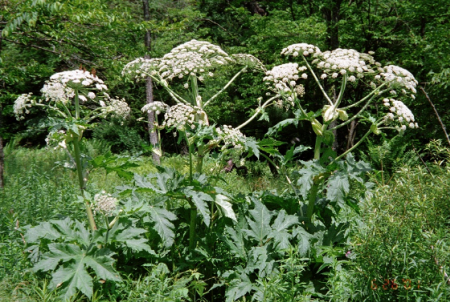Click below to listen to my 2 min. Garden Bite radio show: Hogweed vs Wild Parsnip
Audio PlayerIs it Wild Parsnip? Is it Giant Hogweed? Is it toxic? Yes, Yes and yes… in the last couple of years there’s been a concerted effort to eradicate the toxic Wild Parsnip which is now growing with abandon in many a ditch around Minnesota, Wisconsin and Iowa. But now there’s another contender for the top toxic title. Giant Hogweed. I first reported on this weed in 2014, it hadn’t quite made it to MN yet… it’s here now.

At first glance you might think they’re the same thing and it’s confusing when some areas actually DO call them the same thing.
This is when we have to revert to Latin. Heracleum mantegazzianum, is commonly known as Giant Hogweed while Pastinaca sativa is commonly known as Wild Parsnip.

It’s important to note the difference in height and the leaves. The Wisconsin DNR reports Giant Hogweed reaches up to 8-20’ when in flower and has hollow, ridged stems covered in coarse white hairs and reddish-purple mottling. An herbaceous biennial or monocarpic perennial that grows as a lowing-laying bushy rosette for at least the first year. In general, will bolt in the second year based on maturation and grow to be 8-20’ tall. The plant dies after seed dispersal.

As for Wild Parsnip, I’ve had this one on Garden Bite before but a reminder, this yellow flowered plant grows from 2 to 5 ft. tall and it’s on Minnesota’s HIT LIST! Wild parsnip typically acts as a biennial as well, forming a rosette of basal leaves the first year, overwintering, and then flowering the second year. Occasionally, it may behave like a perennial.

Both plants sap, however, causes something called phytophotodermatitis in humans, resulting in blisters and scars. The New York Dept. of Environmental Health has a lot of information on Health hazards and safety instructions regarding giant hogweed… it’s not pretty!


The most important control is to not allow these plants to go to seed. These plants really aren’t anything to trifle with, the burns can leave some nasty scars.
